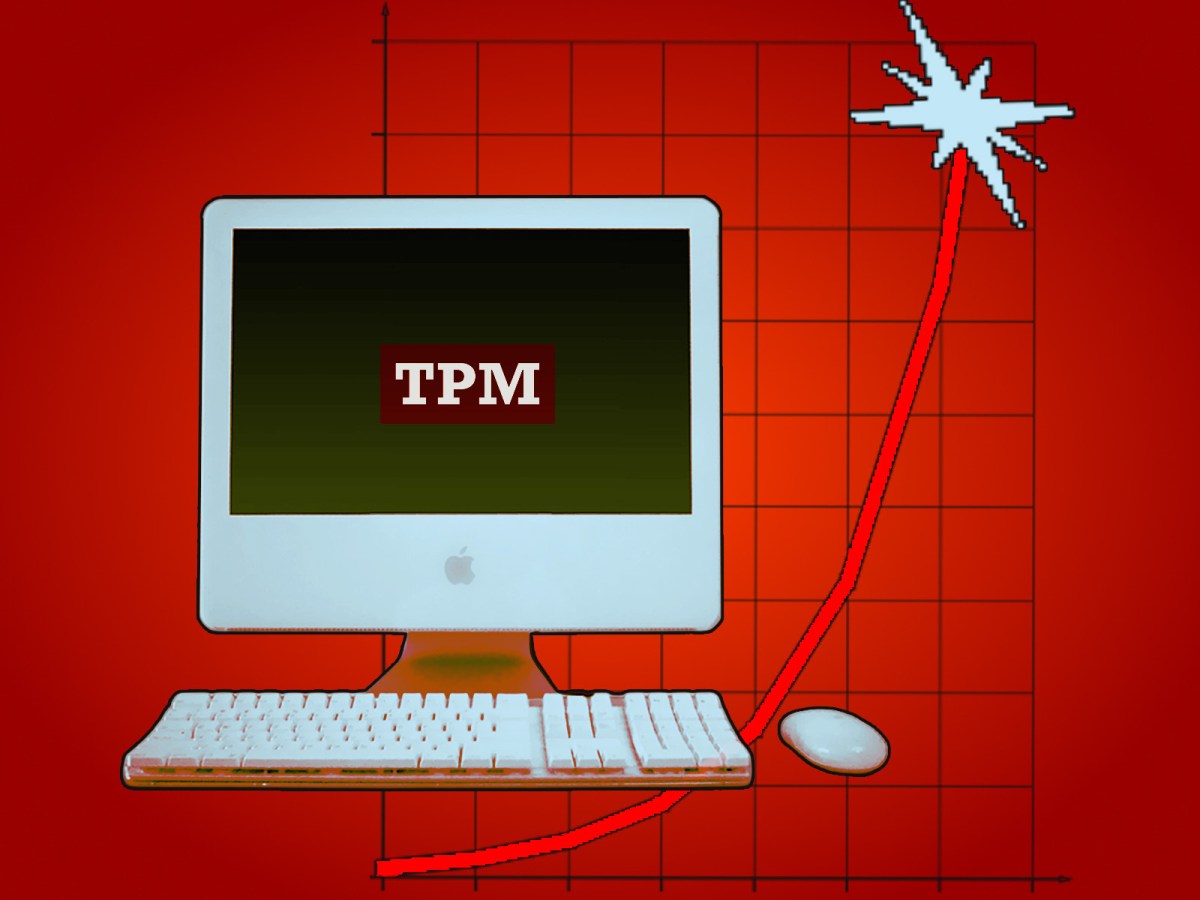I want to begin this introduction to our 25th anniversary essay series by telling you what an exciting and must-read collection it is. Our team has commissioned 25 essays on the history of digital media, which more or less overlaps with the 25 years we’re celebrating here at TPM this year. We solicited contributions from a wide range of contributors — people who first made their mark at different points in the history of digital media, people who’ve worked in different parts of the digital beast, people from very different political persuasions. We have Semafor’s Dave Weigel on Elon Musk and X; Jacobin founder Bhaskar Sunkara on the rise of Substack; Gawker founder Elizabeth Spiers on blogging; Marisa Kabas of the Handbasket on journalists as personal brands; Marcy Wheeler (Emptywheel) on troll culture and the rise of Trumpism. That only scratches the surface on the series we’re kicking off today, and running through our two-day anniversary event in New York City on Nov. 6 and 7.
I also want to thank every member of the current TPM team, the countless rising journalists who’ve toiled with us over the last 25 years who’ve made this quarter century possible, and you, our readers. This site’s relationship with our readers and, even more so, my relationship with TPM’s readers has always been difficult to describe without appearing to lapse into nostalgia or platitude. I can only tell you that it’s all true. I’d already been writing professionally as a journalist for about three years when I started TPM, and I experimented briefly with a sort of proto-TPM at The American Prospect shortly before my…well, departure. In that time, I’d gotten maybe a handful of responses or comments on anything I’d written. In the first two or three weeks of writing TPM — when there were a few dozen readers — I got reply after reply. They flowed in. They provided encouragement; they added additional information that hadn’t occurred to me; they pointed me to new bits of news I hadn’t seen yet. If you’re not old enough or simply don’t remember, this was long before any social media. So the ability to find newly-published information — to even know to look for it — came at a premium. And with a rapidly expanding network of readers, I was often finding out about those stories faster than anyone else.
More than these individual practical advantages, the interaction was a revelation to me. I was attracted to this medium because I could see the opportunity to write in the way I thought, which was the way I spoke. I wanted that. It seemed liberating to me. But I quickly discovered this circular, mutual interaction. Journalistic writing had been an entirely one-way experience for me. I imagined an audience reading what I wrote in the Prospect or Salon. But it was pretty much all imagination. Now there was this two-way dimension to the whole dynamic. A mix of the ease of email sending and the conversational style I was writing in pulled people out of the woodwork. The more I wrote, the more information I got, the more ideas were spawned. There was this virtuous cycle created by this intensive interaction with readers, even when they were counted only in the dozens and then hundreds. It is difficult for me to convey the excitement of this experience. It was a style of writing and a venue in which I could express my insights and impressions, and — really so much more important — in which all those quirks and idiosyncrasies of my personality were suddenly unalloyed advantages. There were times running this site in 2004 and ‘05 and ‘06 and ‘07 that it really did feel, in some very small way, like you were running with history.
There were other little moments along the way that opened my eyes to other possibilities. I may have some of the details wrong here. But my best recollection is that sometime in the middle of 2003, Atrios (Duncan Black) announced on his blog that his laptop had died and asked if people would chip in money for a new laptop. They did. My laptop was fine. But I remember thinking, Fuck…That’s a thing. Okay. That was the kernel of my idea to ask readers to fund a reporting trip to cover the New Hampshire primary a few months later. And that was a proof of concept for a series of future fundraisers that financed launching new TPM subsites from 2005 to 2007: TPMCafe, TPMMuckraker, et al. That grew the experience and insight that led to starting a membership program in late 2012, way earlier than the great majority of other sites. And that’s why TPM still exists today, because of that one decision. By the late 2010s when the storm really hit we already had about 20,000 subscribers and time and revenue enough to make it the rest of the way.
And this gets me to what I wanted to discuss in this essay — because in addition to introducing the series and saying some thank yous, there was one point I wanted to make to contextualize the overall series. What is the history of the last 25 years of digital media? A bit more than half of that time was, first, a period of immense creativity and increasingly grandiose expectations followed by another decade or more of continuous carnage.
Why was it so? The original sin of the whole arc of digital media was the belief that digital media was part of the tech business. That was both the cause and effect of the boomlet of techcentric venture capital that flowed into digital media starting around 2004 and 2005, right about the time the dot com bust hangover was receding into the rearview. Tech investors talk about “hockey stick growth.” It’s what it sounds like if you imagine a hockey stick as a growth chart with the blade facing to the left: a period of incremental growth followed by explosive growth that is basically straight up. Tech investors are happy to lose everything on nine of 10 investments if they can get one case of that hockey stick growth. It’s worth taking a moment to understand how and why that makes sense in the tech economy. Profitability doesn’t really matter, not in the critical growth phase. If anything, if you’re not burning a lot of money you’re probably not being aggressive enough. You’re trying to grow fast, build “network effects” and then “lock in.” If you win the race to be Google or Facebook, the returns are beyond imagination. And with network effects (think about that old story about Betamax and VHS) it’s going to be hard to dislodge you and your immense profitability. This basic framework is at the heart of the modern tech industry and the venture capital world which remains umbilically connected to tech.
But journalism doesn’t work that way. Not because it’s important or noble or any other high-toned talk. There just aren’t network effects and there’s no lock in. There’s no feature of news consumption by which one news source gets better or cheaper or more useful because everyone else is already using it. If anything, quite the opposite. There’s always a different way to cover the news, a different style, a higher or lower tone, a different ideological outlook. You’re never going to invest in the right news start up and it totally explodes and suddenly it owns news like Google owns search or Stripe owns credit card payments. If you’re middle aged or older, you grew up in a world of metropolitan newspapers, a very profitable business before the internet. They had a version of lock in because print newspaper publishing was highly capital intensive and distribution became much harder (and less useful) over great distances. But, of course, the internet totally changed that. No one quite explicitly said to themselves, This start up is going to be the Stripe of news. But if you looked closely at the arc of the years between 2005 and 2015 or so, those assumptions underlay hundreds of millions of investments in the digital news space. It never made sense. And thus you have the carnage we all know about and many of us experienced directly. Eventually the investors realized there were no network effects or lock in and the money disappeared.
You had a whole generation of incredibly smart, creative, talented journalists who cut their teeth, produced amazing journalism and made their names at publications that in the great majority of cases never made a dime and often only pretended to be solvent. As I said, it’s the original sin of the digital journalism world. Digital journalism was never part of the technology business.. To use Warren Buffet’s metaphor, there were simply no good moats to justify the runaway investment in media startups in that critical 10-year period.
And this was only one part of the tech world’s grand pincer movement disemboweling the digital journalism world. Journalism has no network effects or lock in. But what we now call social media absolutely did. And it quickly grew large enough that it simply no longer needed journalism, found it superfluous and powered on to the world we know today. And here we are.
I used to tell people that while there were all sorts of challenges to being a super small publication, there were a few benefits. One is having to actually bring in more money than you spend. This is an important check on exuberance and over-confidence. The other is that as a small publication you never indulge the fantasy that you can buck the industry trends you see around you. Size and successive rounds of new investment can sustain that illusion.
I say all of this about network effects and lock in and venture investment because at one point I bought into it, at least a bit. I’m not sure I believed it but I pitched ideas based on its logic and made some decisions on that basis as well. We were sort of in this go-go mode in 2010 and 2011 and 2012. But over the course of 2012, you could already see some of the cracks in the edifice of digital journalism’s start-up era. That’s why I was so focused on launching a membership program with the updraft of the 2012 election. And it was that membership program, though we didn’t have the organizational focus to really build it aggressively until 2014 and 2015, that is why this publication still exists. Because of you.
So, our readers weren’t just a source of tips and insight and commentary. They also had to be the basis of the business itself. That first year of the membership program — from late 2012 until late 2013 — was the most arduous and stressful of the entire 25 years of our operation. I knew there were a lot of people inside and outside of the organization that thought we were spiraling and done for. But I had a plan to right the ship, and I was totally committed to it. In most ways, I feel more satisfaction in saving the organization that year than creating it in the first place. The first was luck, being at the right place at the right time, having the wind at your back. Now the wind was at my back again but blowing straight down. It took a lot of determination and a certain inflexibility, a lot of saying no again and again and again to people who really wanted to hear yes. And the key was making bets on the things that TPM could do as well or better than anyone else.
Thank you for being there for us through all of it. Enjoy the series.










